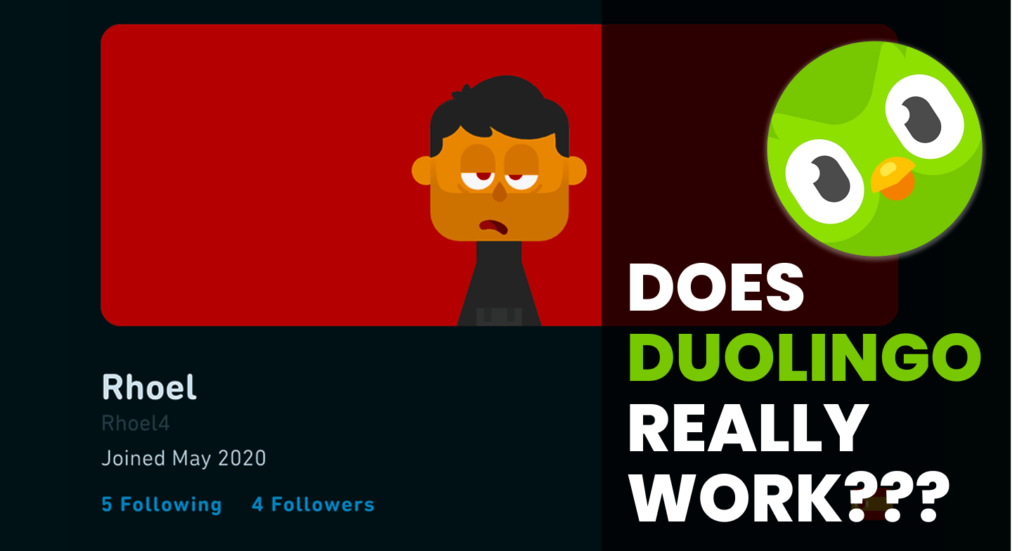In this Duolingo review, I’m sharing my honest, no-fluff thoughts based on my own experience. If you’re here looking for a first-hand perspective before downloading the app—especially if you’re planning to learn Spanish—you’re in the right place. I’m laying it all out: does Duolingo work, or is it just riding the hype?
There’s no doubt that Duolingo is the go-to app for language learners. With over 100 million active users every year, it’s everywhere. Before I moved to Madrid, I used Duolingo myself—for over a year, actually.
But did it help me? Did it get me ready to speak Spanish in real life? And would I recommend it to fellow language learners?
Quick Summary
What is Duolingo
Duolingo is a language-learning app that teaches through quick, bite-sized lessons. It feels more like a game than a class—you earn points, keep streaks, and unlock levels as you go. It covers reading, writing, listening, and speaking, and you can choose from over 40 languages. It’s designed for daily practice, even if you only have a few minutes to spare.
How Duolingo´s Lessons Work
Duolingo introduces new vocabulary in small, manageable doses—usually just two to four new words per lesson. It doesn’t overwhelm you. Instead, it mixes new terms with ones you’ve already seen, which helps reinforce what you’ve learned.
Lessons are grouped into paths or units like “Greetings,” “Food,” or “Past Tense.” Each topic focuses on a small set of words or a specific grammar concept, so it feels approachable.
New words are easy to spot—often bolded or underlined—and you can tap them to check the meaning. If you make a mistake, Duolingo immediately shows the correct answer, and you’ll see that word again later to help it stick.
Some lessons also include a “Tips” section before you start. It’s written in your language and explains grammar or tricky parts clearly, without too much jargon.
You earn XP, collect gems, try to keep your streak going, and unlock levels. It makes the experience feel playful, but underneath it all, it’s teaching you real patterns and structures.
Each lesson includes several mini tasks, mixing different types to keep things engaging:- Translation Tasks
- Listening Exercises
- Speaking Practice
- Match Words
- Fill in the Blank
- Tap the Words in Order
Example Flow of a Lesson
Let’s say you’re doing a Spanish lesson on food:- New words introduced:
- “pan” – bread
- “Yo como” – I eat
- Match exercise
- Match “pan” with bread
- Match “Yo como” with I eat
- Fill in the blanks:
- “Yo _____ pan” choose “como”
- This teaches subject–verb–object structure (I–eat–bread)
- Listening task:
- Hear “Yo como pan”
- Type what you hear → reinforces listening + spelling
- Speaking task:
- Say “Yo como pan.” aloud
- Practice pronunciation
- Translate into English:
- “Yo como pan.” → “I eat bread”
- “I eat bread.” → “Yo como pan”
Duolingo Pricing (as of 2025)
Super Duolingo:- Monthly: 16,99€
- Yearly: 101,99€
- Student Plan (Yearly): 101,99€
- Family Plan (Yearly): 122,99€
- Monthly: 39,99€
- Yearly: 179,99€
- Family Plan (Yearly): 239,99€
Duolingo´s Features
1. Learn Section: This is your main hub. It’s where you go through lessons step by step. You’ll practice reading, writing, listening, and even a bit of speaking—all mixed into short, interactive tasks.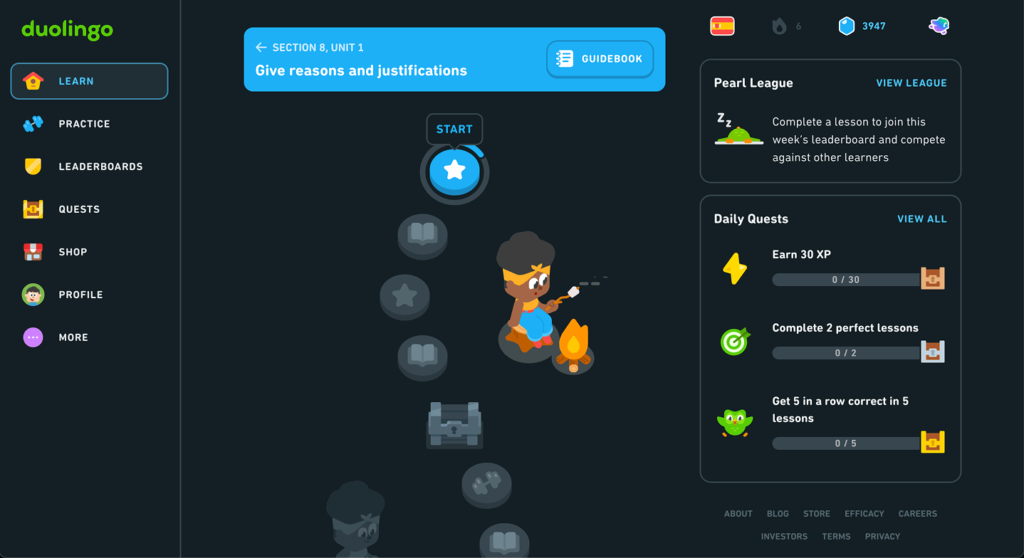
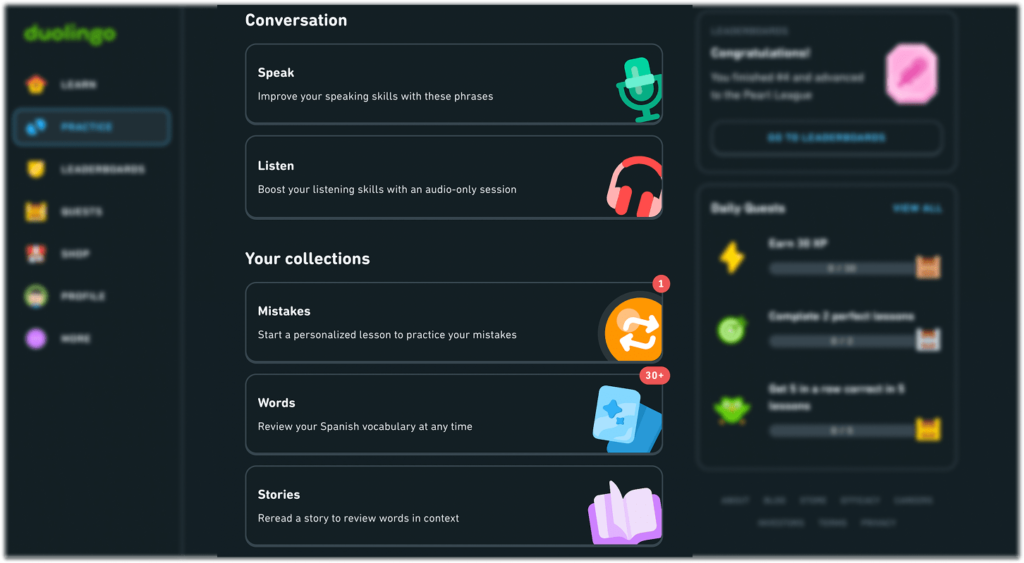
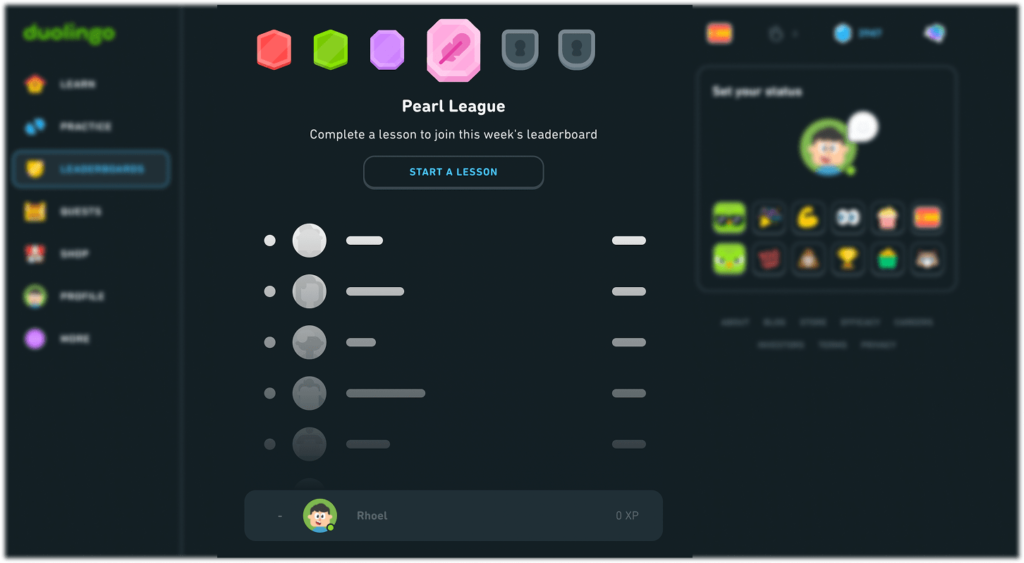
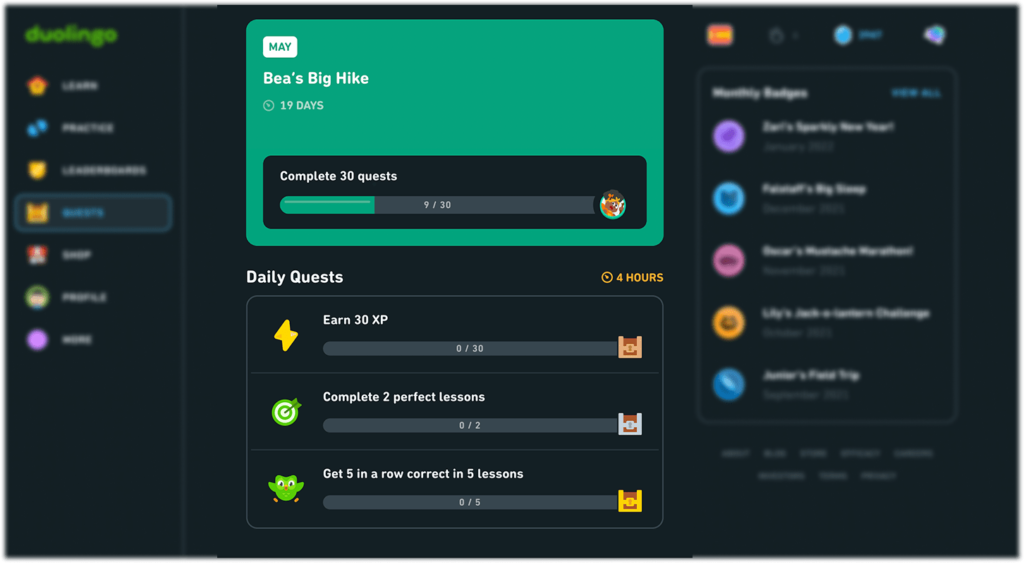
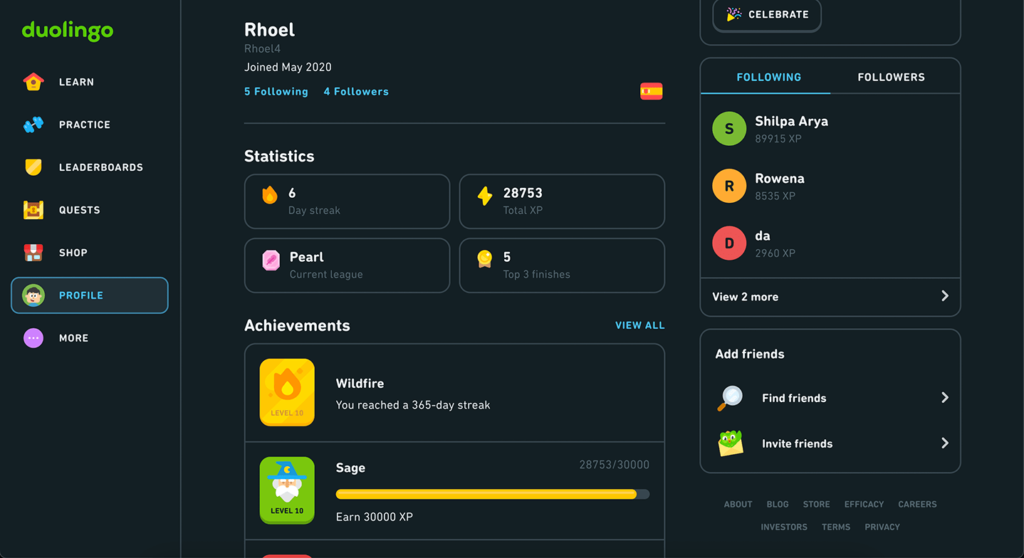
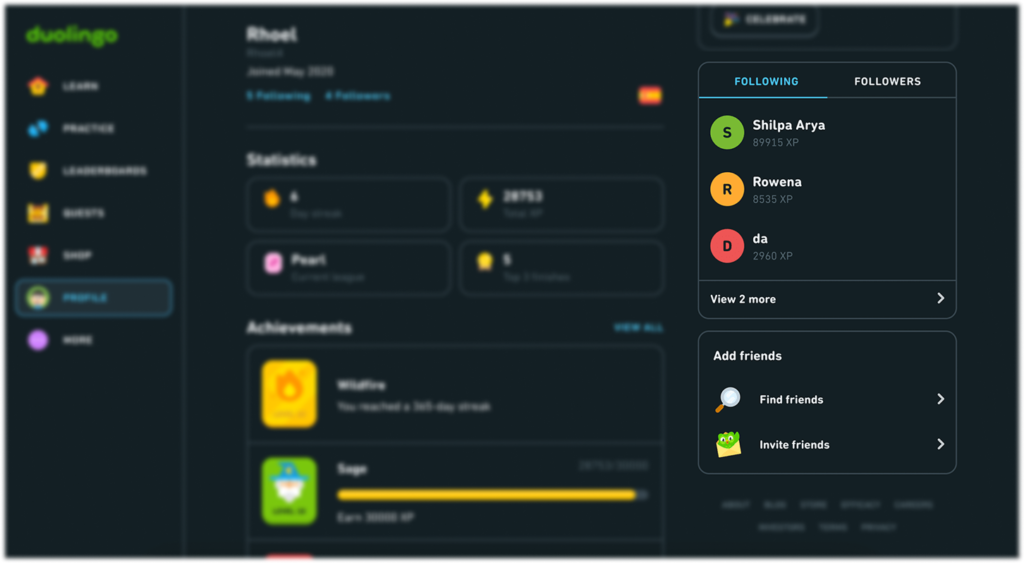
What I Like About Duolingo
1. Highly Gamified
The points, streaks, hearts, and leagues make it feel like a game—you’ll keep coming back without even thinking about it. One of the hardest parts of learning a new language is building a consistent habit. Duolingo helps with that by making the process feel rewarding. You earn XP for every lesson, compete with others in leagues, and keep your daily streak alive. Run out of hearts? You’ll want to come back and earn more. Hit a new streak milestone? You’ll feel proud enough to keep going. It’s simple psychology—but it works. The app is designed to give you constant feedback and little wins, so showing up every day becomes second nature.
2. Good User Interface
Duolingo’s design is clean, simple, and intuitive. Whether you’re using it on mobile or desktop, everything flows smoothly and is easy to find. The user-friendly layout makes it accessible for anyone, even if you’re not tech-savvy—getting started takes no time, and there’s no confusion as you move through lessons.
3. Follows CEFR Levels
Duolingo’s course design generally follows the CEFR levels, ranging from A1 to B2 (depending on the language). For me, this was really helpful because it gave me a clear sense of where I was in my learning journey. Knowing your level allows you to track your progress and stay motivated as you move up. Plus, it ensures the lessons are challenging but not overwhelming, so you always feel like you’re making steady progress without getting lost or frustrated.
4. Covers the Basics Early On
What’s also great is that Duolingo focuses on key, real-life topics—like self-introductions, expressing likes and dislikes, and basic conversation skills—that you need to know as a beginner. These are the kinds of things you’ll be using in everyday conversations, so it’s great that Duolingo covers them early on. By the time you reach higher levels, you’ve already had a good foundation that can actually help you navigate real-life situations.
If you’re just starting out with Spanish, I highly recommend familiarizing yourself with the CEFR (Common European Framework of Reference). It will guide you on what to focus on at each stage of your learning journey. Check out this article to get a clearer idea of what you should learn as a beginner and what’s expected of you along the way.
5. Multiple Languages
Duolingo offers the chance to explore over 40 languages, from popular ones like Spanish and French to more unique options like Japanese and even Hawaiian. Plus, they’ve expanded beyond just spoken languages—now you can dive into subjects like Math and Music, making it a fun, diverse platform for learning anything that piques your interest.
6. Quick and Easy to Use
Another thing I love about Duolingo is how quick and accesible the lessons are. They’re short enough that I can squeeze them in during my siesta or while waiting for the metro. Even if I only have 5 minutes, I can still make little progress, which makes it so much easier to stick with it. It’s perfect for those days when I don’t have a lot of time but still want to keep the language learning habit alive.
What I Don´t Like About Duolingo
1. Weak Grammar Explanations
Each lesson comes with a Guidebook, which is basically a short page that gives a quick rundown of the grammar or sentence structure you’re about to learn. It’s helpful at first—but only to a point. I’ve often found the explanations too brief or too simplified. There were times when my answer was marked wrong and I had no idea why, so I had to look it up elsewhere. And it turns out I’m not the only one—I’ve seen plenty of posts on forums and social media from other learners confused about the same thing. Duolingo doesn’t always explain the “why” clearly, which can be frustrating if you’re trying to understand the grammar.
2. No SRS (Spaced Repetition System)
Duolingo doesn’t seem to have a true spaced repetition system—the kind that reminds you to review words right before you’re about to forget them. Some blogs and forums say it’s there, others say it’s not, but even Duolingo doesn’t clearly confirm it. And honestly, from my own experience, it doesn’t feel like it’s built in. I’ve had to manually track which words I’m forgetting and review them on my own. For an app that costs this much, I expected it to include something as essential as SRS. For me, it’s not just a nice-to-have—it’s important if I want the things I’ve worked hard to learn to actually stick long term.
3. Overpriced for What It Offers
Especially at the higher tiers, Duolingo feels expensive for what it actually delivers. I already consider my Netflix (€6.99/month) and Audible (€9.99/month) subscriptions as a bit of a splurge, but Duolingo Max at €40/month? That’s hard to justify. And what’s frustrating is that this is the only tier that gives you instant explanations for your mistakes through their AI. Honestly, Duolingo is charging extra for things that many people would expect to be part of the normal experience. For an app that still lacks depth in grammar and conversation, the price just doesn’t match the value—for me, this almost feels like a scam.
4. Not Great for Speaking
Yes, Duolingo includes speaking and listening exercises in most lessons, and there are extra drills you can do separately too. But the reality is—they don’t prepare you for real conversations. There are a couple of reasons for this.
First, the speaking drills are just repeating what you see on the screen. You’re basically reading aloud, not actually thinking or forming your own sentences. Sure, it might help with pronunciation, but it doesn’t help when you’re in a real situation and need to recall words on your own.
Second, the listening exercises are super clear and slow—almost too easy. Native speakers don’t talk like that. When I moved to Madrid after using Duolingo for over a year, I realized I wasn’t used to real-life Spanish at all. I could recognize some words, but I couldn’t keep up or respond naturally. Duolingo just doesn’t train that muscle of reacting in real time or building your own thoughts in the language.
5. Artificial-sounding Sentences
Some of the phrases Duolingo teaches just feel off. Sure, they’re technically correct, but I’ve come across sentences that no native speaker would ever say in real life. Something like “My sister eats apples” or “The bear wears a hat.” At first, it’s quirky and kind of funny, but after a while, it feels like a missed opportunity. I’d rather practice with sentences I might actually use in conversation. As someone who is already living in Madrid, I want phrases that will help me get through a day in a Spanish-speaking country—not talk about oddly dressed animals.
6. Too Much Hype
Duolingo is hands down one of the most popular language apps out there—and for good reason. It’s fun, accessible, and helps you build a habit. But I honestly think it’s a bit overhyped. It’s often marketed as the tool to become fluent, when in reality, Duolingo alone won’t get you there.
They even have their own page showing off studies, stats, and student testimonials saying they made huge progress in just a few months. And sure, I believe some of that—Duolingo can absolutely help you start learning a language. But let’s be real: to actually hold a conversation, understand native speakers, or express your own thoughts fluidly, you’ll need more than just this app.
I still think it’s a great tool, especially in the beginning. But the way it’s promoted can set unrealistic expectations. Fluency takes time, effort, and exposure to real-life language use—and Duolingo is just one small part of that journey.
Does Duolingo Work? (My Honest Opinion)
So, does Duolingo work? Language learning apps like Duolingo is a great starting point to get exposed to a new language, understand the basics and how the language works, and keep your motivation going. But you’ll still need to go beyond it. Talk to people. Watch shows. Read. Make mistakes. And most importantly—keep going. Duolingo can help you start your journey, but it won’t carry you all the way to fluency by itself.
If your goal is to become fluent just by tapping through an app a few minutes a day—then no, Duolingo won’t get you there. But if you’re looking for a way to get started, build a habit, and learn the foundations of a language, then yes—Duolingo does work.
Personally, it didn’t make me fluent—not even close. But it was a good starting point. It gave me a glimpse of what I was up against: the confusing verb conjugations, the grammar that doesn’t always follow logic, and the completely different ways we express things in Spanish.
Set Realistic Expectations
I think a lot of people, myself included at one point, fall into the trap of wanting to speak fluently right away. And I get it—who wants to spend months or years stumbling through awkward sentences, making mistakes, and feeling like you’re not improving fast enough? It’s frustrating. But learning a language takes time. Like, a lot of time.
Why Duolingo Can´t Make You Fluent
What most language learning apps, including Duolingo, can’t really give you is real-life conversation practice. That means thinking on your feet, forming your own sentences, reacting naturally, and dealing with different accents and speeds. Apps train you to repeat and recognize patterns, but they don’t train you to respond in a real conversation where there’s pressure, spontaneity, and unpredictability. That’s a whole different skill set—and it only comes from interacting with real people.
That said, what Duolingo does really well is help you build a habit. It makes showing up every day feel easy and even fun. It also teaches you essential vocabulary, basic grammar structures, and key phrases you’ll actually use as a beginner. And honestly, that part is super underrated. You need those building blocks before anything else.
Would I Recommend Duolingo?
Yes—but with some conditions. I’d recommend Duolingo for beginners or intermediate learners who need a little motivation to stay consistent, and don’t mind spending money for a well-designed, gamified experience. It’s a solid entry point, especially if you’re struggling to build a language learning habit. The streaks, the rewards, the short lessons—it all makes it easy to show up, even on your busiest days.
Why I Stopped Using It
Personally, I don’t use Duolingo anymore. It’s just too expensive for what it offers—especially when there are other apps that give me the same (or better) value for less. I still appreciate that Duolingo helped me reinforce the basics, but I eventually realized that I could do that with cheaper or even free resources.
The Grammar Gap
One of the biggest reasons I moved on is the lack of in-depth grammar explanations. As much as I’ve always avoided grammar (ugh!), I started to see how important it really is. It made me realize that by learning grammar it helped me understand Spanish speakers more effectively. It´s basically a way to identify language patterns.
What I Use Instead
If you’re an adult like me and want something free but way more useful than Duolingo, go check out this blog post—I´ll reveal to you what free app I use now, and honestly, it helped me more than Duolingo ever did.
Why I Don´t Support Duolingo Anymore?
Replacement of Human Translators with AI
One of the big reasons I can’t get behind Duolingo anymore is their decision to replace human translators with AI. Honestly, it feels like they’ve put profits ahead of quality. While I get that AI is cheaper, it’s disappointing to see that they prioritized cutting costs over keeping human expertise in the loop. Users, myself included, started to notice the decline in translation quality, and that was a big red flag for me.
Treatment to Volunteers
Another thing that really got to me was how Duolingo relied on volunteers for years to build its courses. These volunteers worked for free, fully aware the content was meant to be free for anyone who wanted to learn. And in the meantime, Duolingo raised over $180 million and is now worth a whopping $2.4 billion. But even with all that money, the original contributors never saw a dime. Duolingo has shifted into a massive, profitable business, but the people who helped build it remain invisible and uncompensated. It doesn’t sit right with me, and I’m sure I’m not the only one who feels this way.
Duolingo Review Summary Pros and Cons
👍 What I Like About Duolingo
- Fun and Gamified – Points, streaks, and leagues keep you coming back daily.
- User-Friendly – Clean design, simple to use on any device.
- CEFR Aligned – Clear levels (A1-B2) to track your progress.
- Variety of Languages – Over 40 languages to explore.
- Quick Sessions – Short lessons fit into any schedule.
👎 What I Don´t Like About Duolingo
- Weak Grammar Explanations – Too brief and not always clear.
- Lacks Spaced Repetition – Doesn’t remind you of words before you forget them.
- Overpriced – Costs too much for what you get, especially at higher tiers.
- Limited Speaking Practice – Doesn’t prepare you for real conversations.
- Unnatural Sentences – Some phrases just don’t sound like something a native would say.
- Overhyped – It’s a great tool but won’t get you fluent alone.

